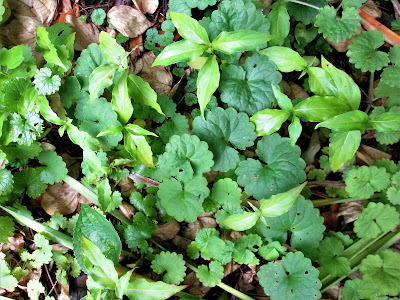So asked the poet Sara Teasdale in her 1915 poem, "Spring Night," and while the speaker in the poem never answers her own question, I would have to say "No." Of course, the sorrowful young woman in the poem is moping about because of her lack of a love interest, while I am complaining about a physically lovely plant that is verging on becoming an invasive in our yard.
I refer to the Asian kousa dogwood, widely planted in the US because of its resistance to the anthracnose that plagues our native Cornus florida. This small tree is definitely a beauty, blooming several weeks after its cousin and possibly for a longer period.
The areas underneath our trees are liberally sprinkled with baby kousas every year. Sometimes they hide behind other plants, and are a foot or more tall before I notice them. When we moved in, several years after the decline and death of the home's previous inhabitant, the walled garden near the house was home to two volunteer kousas nearly as tall as I. But free trees are a good thing, right?








